常用翻译技巧——重复法
- 格式:pptx
- 大小:109.83 KB
- 文档页数:2
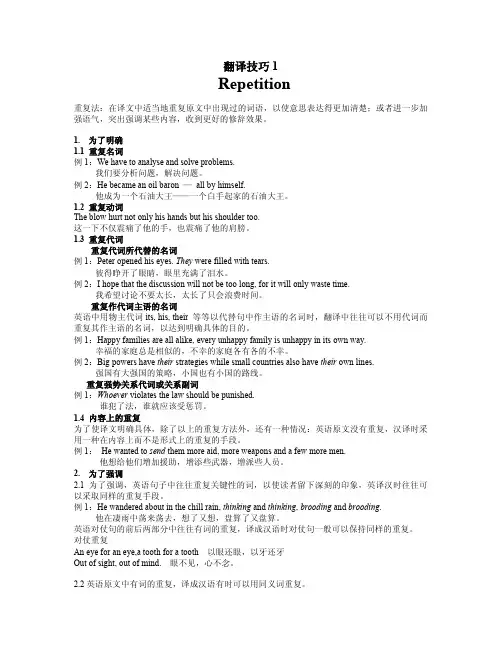
翻译技巧1Repetition重复法:在译文中适当地重复原文中出现过的词语,以使意思表达得更加清楚;或者进一步加强语气,突出强调某些内容,收到更好的修辞效果。
1.为了明确1.1重复名词例1:We have to analyse and solve problems.我们要分析问题,解决问题。
例2:He became an oil baron—all by himself.他成为一个石油大王——一个白手起家的石油大王。
1.2重复动词The blow hurt not only his hands but his shoulder too.这一下不仅震痛了他的手,也震痛了他的肩膀。
1.3重复代词重复代词所代替的名词例1:Peter opened his eyes.They were filled with tears.彼得睁开了眼睛,眼里充满了泪水。
例2:I hope that the discussion will not be too long,for it will only waste time.我希望讨论不要太长,太长了只会浪费时间。
重复作代词主语的名词英语中用物主代词its,his,their等等以代替句中作主语的名词时,翻译中往往可以不用代词而重复其作主语的名词,以达到明确具体的目的。
例1:Happy families are all alike,every unhappy family is unhappy in its own way.幸福的家庭总是相似的,不幸的家庭各有各的不幸。
例2:Big powers have their strategies while small countries also have their own lines.强国有大强国的策略,小国也有小国的路线。
重复强势关系代词或关系副词例1:Whoever violates the law should be punished.谁犯了法,谁就应该受惩罚。
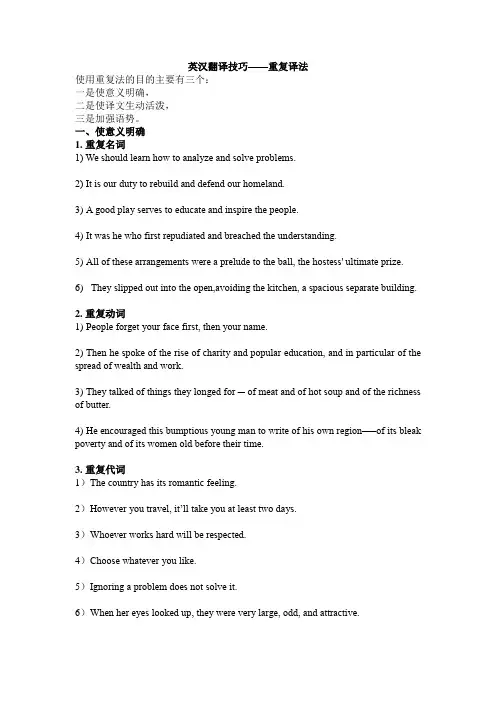
英汉翻译技巧——重复译法使用重复法的目的主要有三个:一是使意义明确,二是使译文生动活泼,三是加强语势。
一、使意义明确1.重复名词1) We should learn how to analyze and solve problems.2) It is our duty to rebuild and defend our homeland.3)A good play serves to educate and inspire the people.4)It was he who first repudiated and breached the understanding.5)All of these arrangements were a prelude to the ball, the hostess' ultimate prize.6)They slipped out into the open,avoiding the kitchen, a spacious separate building.2.重复动词1)People forget your face first, then your name.2)Then he spoke of the rise of charity and popular education, and in particular of the spread of wealth and work.3)They talked of things they longed for ─ of meat and of hot soup and of the richness of butter.4)He encouraged this bumptious young ma n to write of his own region──of its bleak poverty and of its women old before their time.3.重复代词1)The country has its romantic feeling.2)However you travel, it’ll take you at least two days.3)Whoever works hard will be respected.4)Choose whatever you like.5)Ignoring a problem does not solve it.6)When her eyes looked up, they were very large, odd, and attractive.二、使译文生动活泼1)grotesque2)careless3)in chaos4)street gossip5)rumors6) Talking and laughing, running and jumping, the children had a good time at sea-side.7) But at that time, she was the only woman there.8) His folks ate up everything he had.三、加强语势1) Would you please please please please please please please stop talking.2)Any my poor fool is hanged. No, no, no life.。
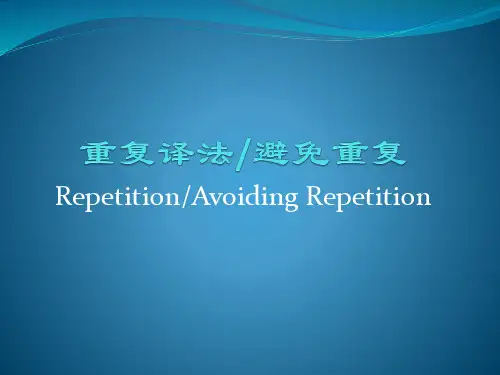
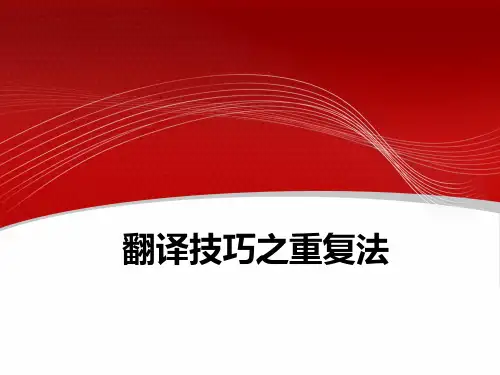
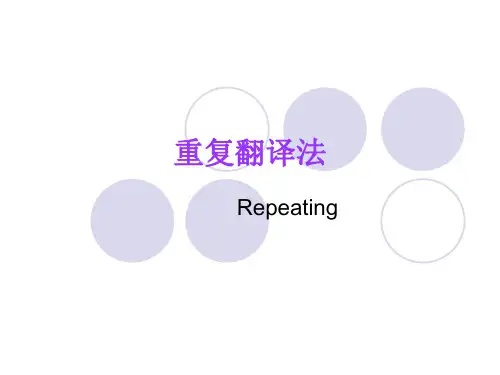

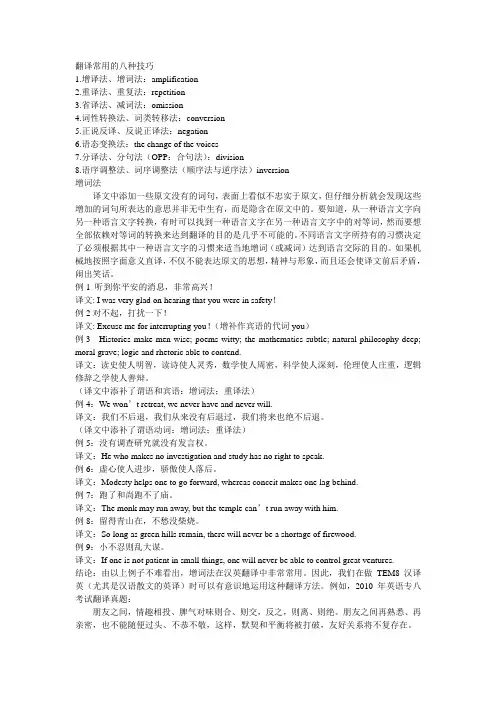
翻译常用的八种技巧1.增译法、增词法:amplification2.重译法、重复法:repetition3.省译法、减词法:omission4.词性转换法、词类转移法:conversion5.正说反译、反说正译法:negation6.语态变换法:the change of the voices7.分译法、分句法(OPP:合句法):division8.语序调整法、词序调整法(顺序法与逆序法)inversion增词法译文中添加一些原文没有的词句,表面上看似不忠实于原文,但仔细分析就会发现这些增加的词句所表达的意思并非无中生有,而是隐含在原文中的。
要知道,从一种语言文字向另一种语言文字转换,有时可以找到一种语言文字在另一种语言文字中的对等词,然而要想全部依赖对等词的转换来达到翻译的目的是几乎不可能的。
不同语言文字所持有的习惯决定了必须根据其中一种语言文字的习惯来适当地增词(或减词)达到语言交际的目的。
如果机械地按照字面意义直译,不仅不能表达原文的思想,精神与形象,而且还会使译文前后矛盾,闹出笑话。
例1 听到你平安的消息,非常高兴!译文: I was very glad on hearing that you were in safety!例2对不起,打扰一下!译文: Excuse me for interrupting you!(增补作宾语的代词you)例3 Histories make men wise; poems witty; the mathematics subtle; natural philosophy deep; moral grave; logic and rhetoric able to contend.译文:读史使人明智,读诗使人灵秀,数学使人周密,科学使人深刻,伦理使人庄重,逻辑修辞之学使人善辩。
(译文中添补了谓语和宾语:增词法;重译法)例4:We won’t retreat, we never have and never will.译文:我们不后退,我们从来没有后退过,我们将来也绝不后退。
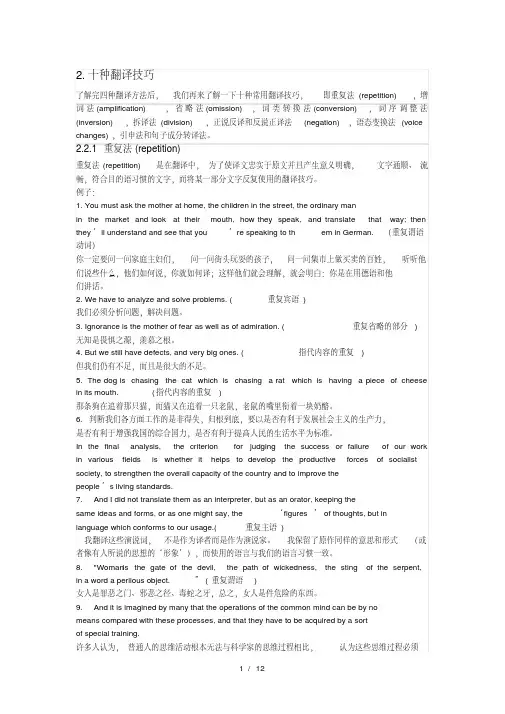
2.十种翻译技巧了解完四种翻译方法后,我们再来了解一下十种常用翻译技巧,即重复法(repetition),增词法(amplification),省略法(omission),词类转换法(conversion),词序调整法(inversion),拆译法(division),正说反译和反说正译法(negation),语态变换法(voice changes),引申法和句子成分转译法。
2.2.1重复法(repetition)重复法(repetition)是在翻译中,为了使译文忠实于原文并且产生意义明确,文字通顺、流畅,符合目的语习惯的文字,而将某一部分文字反复使用的翻译技巧。
例子:1. You must ask the mother at home, the children in the street, the ordinary manin the market and look at their mouth, how they speak, and translate that way; then they’ll understand and see that you’re speaking to th em in German. (重复谓语动词)你一定要问一问家庭主妇们,问一问街头玩耍的孩子,问一问集市上做买卖的百姓,听听他们说些什么,他们如何说,你就如何译;这样他们就会理解,就会明白:你是在用德语和他们讲话。
2. We have to analyze and solve problems. (重复宾语)我们必须分析问题,解决问题。
3. Ignorance is the mother of fear as well as of admiration. (重复省略的部分) 无知是畏惧之源,羡慕之根。
4. But we still have defects, and very big ones. (指代内容的重复)但我们仍有不足,而且是很大的不足。


考试复习一、英汉互译下列习语(每小题2分,共20分)书上或日常生活中常出现的一些习语或成语。
二、将下列句子翻译成中文,并指出使用的翻译技巧(每小题3分,共30分)翻译常见的八种技巧:1.重复repetition在翻译中被称为一种技巧,自然就不是一般所说的不必要的重复,而是一种必不可少的方法。
可以这样确定它的定义:在翻译中,有时为了忠实于原文,不得不重复某些词语,否则就不能忠实表达原文的意思。
这种反复使用某些词语于翻译的方法就叫重译法。
一般说来,重译法有如下三个作用:一是为了明确;二是为了强调;三是为了生动。
We have to analyze and solve problems.我们要分析问题,解决问题。
2.增译addition/amplification什么叫增译法我们可以这样确定它的定义:为了使译文忠实地表达原文的意思与风格并使译文合乎表达习惯,必须增加一些词语,这就叫增译法。
,yet the parting must come at last.3.减译法deletion和其他一切事物一样,翻译也是有增必有减。
懂了增译法之后自然也就会懂得什么是减译法。
它是增译法的反面:以同一个译例来说,在英译汉中如果用增译法的话,在汉译英中自然就要用减译法了。
把第二节中的31个例子倒译的话(即把汉译英改为英译汉或把英译汉变为汉译英),所用的译法就不是增译法而是减译法了。
关于减译法,应该记住这样一条总原则:减译法是指原文中有些词在译文中不译出来,因为译文中虽无其词而已有其意,或者在译文中是不言而喻的;换言之,减译法是删去一些可有可无的,或者有了反嫌累赘或违背译文习惯表达法的词,但减译并不是把原文的某些思想内容删去。
此外,冠词、连词、代词(尤其是人称代词、关系代词)、关系副词,等等,在英语中经常使用,但译成汉语时几乎很少出现,要使译文忠实而地道,减译法就自然必不可少了。
例如:A book is useful.书(是)有用(的)。

重译法Repetition (重译法)1.重复名词⼤家都知道,英语句中若两个动词共⽤⼀个宾语,宾语只在第⼆个动词之后出现⼀次。
⽽在汉语中,这样的宾语要在每个动词后出现,定语后的名词也如此。
重复动词后的宾语名词,如:1). We have to analyze and solve problems.我们要分析问题,解决问题。
2). Let us revise our safety and sanitary regulations.我们来修改安全规则和卫⽣规则吧。
重复英语中作表语的名词1). John is your friend as much as he is mine.约翰既是你的朋友,⼜是我的朋友。
2). This has been our position –but not theirs.这⼀直是我们的⽴场——⽽不是他们的⽴场。
3). He became an enterpriser—all by himself.他成为⼀个企业家——⼀个⽩⼿起家的企业家。
重复英语中省略的名词,起到强调和明确的作⽤,更符合译语习惯1). I have fulfilled my assigned work ahead of schedule, so has he.我已经提前完成了交给我的⼯作,他也提前完成了交给他的⼯作。
2). Ignorance is the mother of fear as well as of admiration.⽆知是恐惧的根源,也是敬佩的根源。
3). Before liberation many people could not read or write.解放前,许多⼈不会读书,也不会写字。
4). But we still have defects, and very big ones.但是我们还是有缺点的,⽽且还有很⼤的缺点。
5). The story of John is a story of groans and tears, of poor human beings destroyed by the capitalist.约翰的故事是⼀篇充满呻吟和泪⽔的故事,是资本家摧残不幸的⼈们的故事。
重复法实际上也是一种增词法,只不过所增加的词是上文刚出现过的词。
翻译和写作一样,本应力求简练,尽量省略一些可有可无的词;但有时为了明确、强调或生动,却往往需要将一些关键性的词加以重复。
一、为了明确(一)重复名词1. 重复英语中作宾语的名词1)Let us revise our safety and sanitary regulations.我们来修订安全规则和卫生规则吧。
2)I had experienced oxygen and / or engine trouble.我曾碰到过,不是氧气设备出故障,就是引擎出故障,或两者都出故障。
3)They began to study and analyze the situation of the enemy.他们开始研究敌情,分析敌情。
4)Thus, I wrote "Spain in Arms, 1937" and saw China in revolution in 1925-27, and later in war with Japan.这样,我就写了《战斗中的西班牙(一九三七年)》。
我也看到了一九二五年至一九二七年正在革命的中国,后来又看到了正同日本作战的中国。
2. 重复英语中作表语的名词1)He became an oil baron -- all by himself.他成为一个石油大王——一个白手起家的石油大王。
2)This has been our position -- but not theirs.这一直是我们的立场——而不是他们的立场。
3)John is your friend as much as he is mine.约翰既是你的朋友,又是我的朋友。
3. 重复英语前置词短语前所省略的名词英语中常重复使用前置词,而将第二个、第三个前置词前的名词省略,翻译时则往往要把此名词重复。
1)The doctor will get more practice out of me than out of seventeen hundred ordinary patients.医生从我身上得到的实践,会比从1700个普通病人身上得到的实践还多。
2.2 练习一参考译文I thought this machine would never be anything but a toy.我原以为这台机器最多只能当成一个玩具,没有什么实用价值。
Early the next morning, after a large breakfast, they departed.第二天一早,饱饱地吃了一顿早餐之后,他们便动身了。
第二天一早,他们吃了一顿丰盛的早餐之后,便出发了。
Do as you would be done by.要别人如何待你,你就该如何待人。
(增加原文比较句中省略的部分)This printer is indeed cheap and fine.这部打印机真是物美价廉。
I could knit when I was seven.我七岁时就会织毛衣。
Steel and iron products are often coated lest they should rust.钢铁制品常常涂上油漆以免生锈2.2.2重复法一.原文为省略表达:英语中和汉语中都有省略现象。
英语多按语法形式省略以避免重复,多省略所有格、形容词和介词后面的名词,助动词、不定式后面的动词,系动词后面的表语,主谓一致时的主语或谓语等。
译为汉语时,这些省略掉的词语往往要补上,这就构成了汉语的重复。
1.重复名词:例1.Aristocratic and democratic tendencies in a nation often show themselves in its speech.一个民族的贵族倾向和民主倾向常在其言语中表现出来。
(重复形容词所修饰的名词)例2.We have advocated the principle of peaceful coexistence, which is now growing more and more popular among the nations of Asia and Africa.我们提倡和平共处的原则,这个原则目前在亚非各国越来越得人心了。
翻译技巧之重复法重复法是指在译文中适当地重复原文中出现过的词语,以使意思表达得更加清楚;或者进一步加强语气,突出强调某些内容,收到更好的修辞效果。
下面就一起来看看具体的重复法翻译技巧吧!翻译技巧之重复法1一、重复名词1.重复英语中作宾语的名词Students must be cultivated to have the ability to analyze and solve problems.必须培养学生分析问题和解决问题的能力。
They would be very reluctant to postpone or cancel the meeting.他们不太愿意推迟这个会议或者取消这个会议。
2.重复英语中作表语的名词This has been our position—but not theirs.这一直是我们的立场——而不是他们的立场。
John is your friend as much as he is mine.约翰既是你的朋友,又是我的朋友。
3.重复英语介词前所省略的名词英语中常重复使用介词,而将第二个、第三个介词前的名词省略,翻译时则往往可以重复这些省略的名词。
The doctor will get more practice out of me than out of seventeen hundred ordinary patients.医生从我身上得到的实践,地比从一千七百个普通病人身上得到的实践还多。
4.重复定语从句中作先行词的名词英语定语从句常用关系词引导,它一方面代表定语从句所修饰的那个先行词(通常是名词、名词短语或代词),一方面在从句中担任一个成分。
汉语中没有关系词,往往需要重复这个作先行词的名词。
He gave ma a book which I kept to this day.他曾经送给我一本书。
这本书我一直保存至今。
Yesterday afternoon, I met an old friend of mine, who said that he would go abroad the next week.昨天下午,我遇到了一位老朋友。